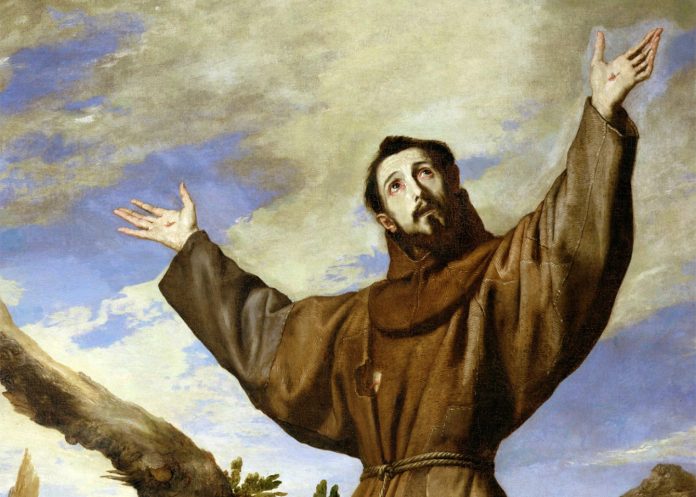Small in stature and having an extrovert personality, Francis always had in his heart the desire to do great things. He demonstrated this in his 20s when he left for the war between Assisi and Perugia, and later to help end the conflict of the crusades.
He was born in 1182 the son of a rich fabric merchant, Pietro di Bernardone, and a noblewoman from Provence, Pica, and grew up occupied with family duties and worldly affairs.
When he returned from his war experience, he was ill and shaken, unrecognizable to all. Something left a deep impression on his soul beyond his experience of the war.
A powerful encounter and a question: Do you serve the servant or serve the Master?
He never forgot the words he heard in a dream while in Spoleto: “Why do burden yourself seeking the servant instead of the Master?”
His life took on a new direction, guided by his constant wish to know that to which God was calling him.
Prayer and silent contemplation in the Umbrian countryside led him to embrace lepers and outcasts as brothers and sisters, those in the past he had always found disgusting and repulsive.
In Spoleto, he heard again a voice breaking the silence of his prayer before a Byzantine crucifix in the small abandoned church of San Damiano.
The voice said: “Francis, go repair my church, which as you can see is in ruin.”
Saint Francis first interpreted that call as an invitation to reconstruct the ruins of the small chapel stone by stone, but in later years he came to understand the full meaning of the call.
He was called to “great things — to renew,” with a spirit of obedience, the Church, which at that time was dealing with divisions and heresies.

Embracing ‘Lady Poverty’
The uncontainable joy unleashed by feeling loved and called by God helped strengthen the wish of young Francis to live by Providence, and in observance of the Gospel, he decided to give away all he had to the poor.
At this point the distance between him and his father, Pietro Di Bernardone, became irreparable. His father denounced him publicly during an audience with Bishop Guido.
Francis declared his deep desire to marry “Lady Poverty,” and he removed his clothes as a way of renouncing his father’s wealth.
Francis gathered his numerous companions, who shared his desire to live the Gospel to the letter in poverty, chastity and obedience.
In 1209, the first group of brothers gathered in Rome to meet Pope Innocent III who, struck by “that short and thin young man with burning eyes,” approved the Rule, later confirmed definitely in 1223 by Honorius III.
The charism of Francis also attracted Clare, a noblewoman from Assisi.
Francis welcomed her and gave origin to the second Franciscan order, “The Poor Clares.” Later he founded the third order for lay people.
The deep love of Francis for Christ, expressed tenderly in the first live Christmas nativity scene in Greccio (Christmas, 1223), led him to the experience of receiving, as the first saint history, the seal of the stigmata.
Francis witnessed the joy of faith drawing even non-believers to the Gospel. He even caught the interest of the sultan who received him with honor in the Holy Land.
The life of Francis was a continuous expression of praise for the Creator.
“The Canticle of Brother Sun,” a poetic masterpiece of Italian literature, was written when he was laid low by illness and expresses the freedom of a soul reconciled with God in Christ.
Saint Francis accepted “sister death” with joy knowing he would be going to Jesus. He died the evening of Oct. 3, 1226.
Francis died at the age of 44 at the Porziuncola, the chapel where he received the gift of the indulgence of the “Forgiveness of Assisi.” He was canonized a saint two years later.
The spirit of Francis continues to inspire so many in following Christ, in building dialogue among all in truth and charity, and in safeguarding creation.









